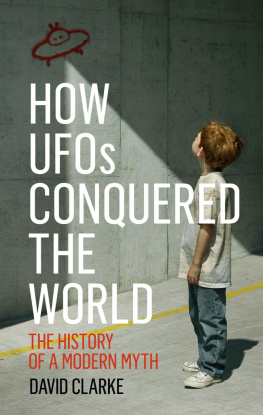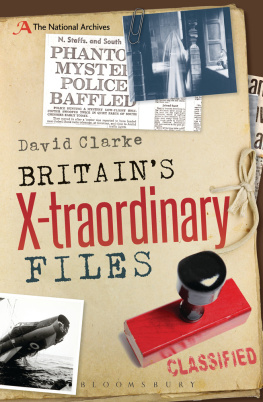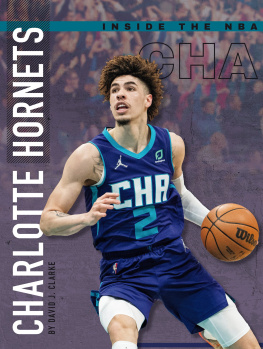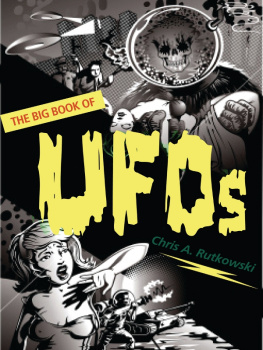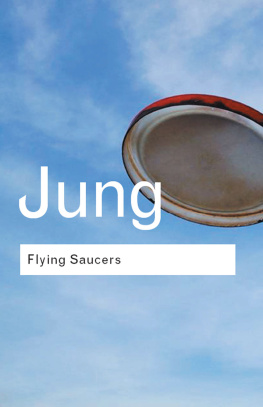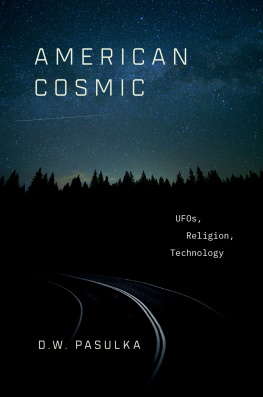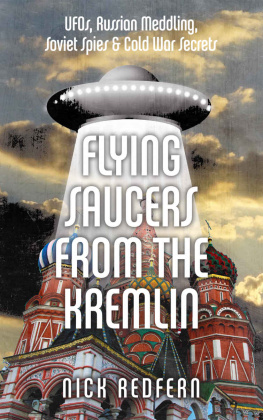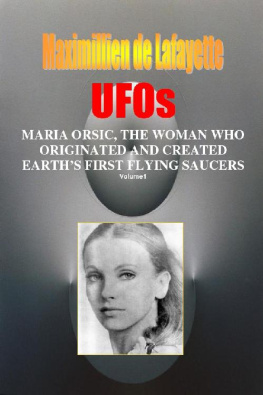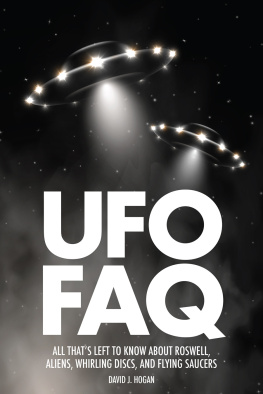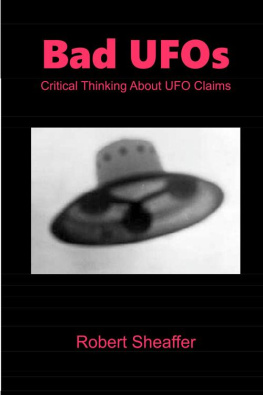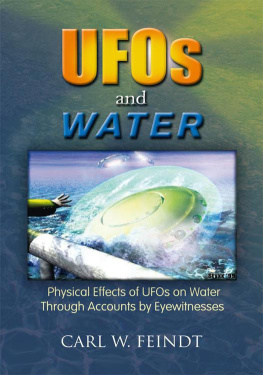How UFOs Conquered the World
For the Duke of Mendoza and fellow pelicanists, but most of all for my Waud-Bee.
Contents
T o steal a clich from the pilot episode of The X-Files this is a true story inspired by actual documented accounts. What follows is distilled from interviews and investigations conducted during three decades of participant observation within the UFO subculture. The role I have chosen to adopt is that of a journalist reporting upon one of the most widespread and pervasive myths of modern times. It is a myth that in little more than six decades has conquered the world.
This book is not intended to be a definitive explanation of the UFO mystery. Neither is my use of the word myth meant to imply that any or all UFO phenomena, or related beliefs, are true or false. My subject matter is not UFOs per se but the people who see and believe in them. For this reason the story is presented in the first person and draws upon a number of journalistic styles including investigative, literary and gonzo. I see it as a rough draft of the history of the UFO syndrome as I have come to understand it. I may be a reporter but like many fellow travellers I also remain a pilgrim on the road to enlightenment. So any errors or omissions are entirely my own.
I owe an enormous debt of gratitude to numerous friends and colleagues who helped in the conception, construction, writing and drafting of this book. First and foremost among these is Peter Brookesmith who provided sources, advice, proofreading, fact checking and wise counsel from the beginning almost to the end. I am also grateful for access to the encyclopedic mind of the indefatigable Marty Kottmeyer. I must, of course, thank my wife Carolyn for her constant and unstinting support, and for adopting the role of avatar at a crucial moment. More thanks must go to Martyn and Steve for helping me to remember; and to Keith for providing technical and IT assistance.
Among the others who deserve specific acknowledgement are the writers and contributors to Magonia, specifically John Rimmer, John Harney, Peter Rogerson and Nigel Watson. Fellow saucerer Andy Roberts as always provided attitude where it was needed; Richard Jenkins supplied papers and key definitions. The late Hilary Evans was ever-helpful before pen was put to paper and I miss his erudition and guidance. Thanks also in no particular order to Ian Ridpath, Bob Sheaffer, Tim Printy, Ben Radford, Robert Bartholomew, Chris French, Jenny Randles, Joe McGonagle, Gary Anthony, Paul Fuller, David Barrett, Mark Pilkington, John Lundberg, John Keeling, Phil Mantle, Nick Redfern, Andrew May and Bill Spaulding for their input both past and present.
I also wish to thank those who, at various stages, agreed to be interviewed both as part of my ongoing research and for the specific purposes of this project. Space considerations meant that many did not make it to the final cut: Denis Plunkett, Alan Biggs, Alex Cassie, Mark Stenhoff, Chris French, Jim Carruthers, John Keel, Kevin Goodman, Gary Heseltine, Father Paul, Lyn Thomas, Dan Denis, Linda Unwin, David Simpson and Paul Davies.
I drew upon a huge collection of archive material in the preparation and writing of this book and am grateful to the staff of The National Archives at Kew, Churchill College, Cambridge, the Broadlands Archives, the BBC Written Archives and the British Library who have assisted with my research during the past two decades.
Last but not least, thanks to Chelsey who found a home for this project and to my editor Sam who skilfully and patiently guided it from birth to launch pad.
I f I could pinpoint the precise moment when my long, strange trip began I would say it was a rainy spring night in 1977. Unusually, my parents had allowed me to stay up beyond the 9 p.m. watershed to watch our prized new colour television and what I saw next sparked something inside me that still remains a huge influence upon my life.
On the screen it was a sunny English afternoon, with scattered clouds and a blue sky, and the camera panned across a vista of green rolling hills. Enter two young men in their early twenties, trudging along a footpath. Something told me these were not ramblers out for a stroll in the countryside: both had bulky headphones clamped over their ears and in their hands were short metal poles attached to shiny dishes, which they jabbed spasmodically at the heavens. They were UFO hunters.
Nothing up in that part of the sky, one advised the other. Try over towards Dorking. As the wind whipped around them, he clasped an unruly anorak with one hand while he manipulated his dish with the other. If theres any spacecraft up there you should pick it up because they have a magnetic force field around them.
His friend sported John Lennon sunglasses, a wispy beard and raffish hair. If theyre here theyre hidden well and truly in the clouds, he retorted, pointing his own dish towards a cluster of fluffy cumulus. Scan along the edge of the cloud because very often they hide. They use the clouds as cover you see, the crafty so-and-sos.
Their daytime search for extraterrestrials on the Sussex Downs came to an end and the men revealed what they did for a living. I work for the London Electricity Board, the man in the anorak explained. And Paul is an embalmer. So we dont get an awful lot of free time.
What we are trying to do is obtain contact or actually pick up some kind of intelligent message from the people who pilot these craft, he elaborated. Although their UFO detectors had failed to find any, their faith remained unshaken.
By now my curiosity was piqued. Like most schoolboys I was aware of UFOs, or flying saucers as they were also known, but I had never encountered adults who took the idea seriously. Later in the programme, a montage of UFO images filled the screen. A drawing showed black objects circling the heavens above a medieval city; another depicted cylinders and discs engaged in aerial combat. The presenter, Hugh Burnett, narrated that strange objects had been sighted in the sky since the beginning of recorded history. They were usually described as circular, disc- or cigar-shaped. During the past century hundreds of photographs had been taken showing what appeared to be UFOs; many had been dismissed as fakes but others remained unexplained. Then the grainy black-and-white images were replaced by colour film footage showing a huge object with a long tail zooming through the atmosphere. Below, groups of people on a beach could be seen gazing upwards in amazement.
From that moment any scepticism I had about the idea that we were being observed by creatures from other worlds evaporated. I was ten years old and spent much of my time soaking up books, comics and television programmes on space travel and science fiction.
At this early stage of my interest in the subject, Burnetts documentary, Out of this World, acted like a marker post. It impressed me because he allowed the people who saw UFOs to explain what they believed and why they believed. It left me searching for more. I had read Edgar Rice Burroughss stories about the adventures of John Carter of Mars, and my growing appetite for science fiction and fantasy had led me to devour John Wyndhams The Day of the Triffids and H. G. Wellss The War of the Worlds. Now words from the opening of Wellss novel drifted into my mind: No one would have believed in the last years of the nineteenth century that this world was being watched keenly and closely by intelligences greater than mans and yet as mortal as his own...
I knew The War of the Worlds and other stories I had read about alien invasions were fiction, but the Cold War with the Soviet Union was very much a fact and throughout my childhood the threat of nuclear annihilation was ever present. My family lived in a post-war, semi-detached house in the industrial heartland of northern England, surrounded at that time by coalmines and steelworks, and my parents ran a car-breakdown business servicing the nearby M1 motorway. During the summer my father, who served in the Royal Navy during the Second World War, would take us to watch the airshow at RAF Finningley, near Doncaster. Finningley was a base for Britains V-bomber force that would, in the event of war, carry tactical nuclear weapons deep inside the Iron Curtain. It was obvious this would make us a prime target
Next page
